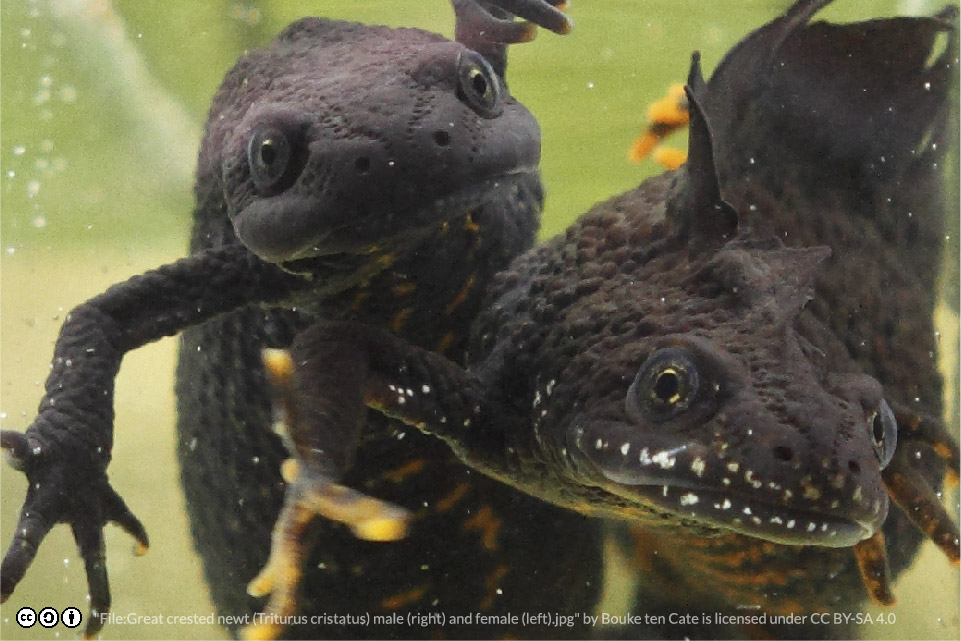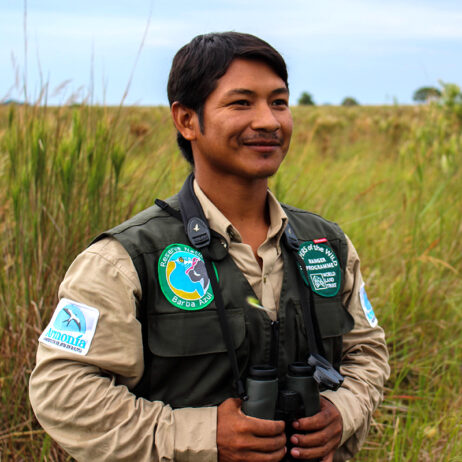
WLT's Donor Support Officer Anne Clifford, shares her stories of conservation and curiosity. Credit: WLT
As part of #OurReasonsForNature series, World Land Trust (WLT) Donor Support Officer Anne Clifford tells us how childhood discoveries of Great Crested Newt spurred on her passion for wildlife and conservation.
Often spending her days peering into ponds and carefully unfurling leaves in the hope of spotting a newt or their eggs, Anne would help her mother survey for Great Crested Newt as research for Froglife – and her love for these semi-aquatic amphibians blossomed from there on.
“It was a treasure hunt and very exciting when we found them. They were everywhere, hanging motionless in the ponds on a spring evening and playing dead every time you lifted a brick,” Anne says, adding that she would fondly call them “Golden Eyed Pond Dragon”.
Great Crested Newt is the largest of the UK’s three native newt species and can grow up to 17cm in length. Their dark warty skin and bright orange belly are the telltale features that Anne would be on the lookout for during her surveys for Froglife.

Great Crested Newt is the UK’s largest native newt species. Credit: Bouke ten Cate
Decades on from such childhood discoveries, WLT’s Donor Support Officer reports finding her beloved “Pond Dragons” from time to time. However, water pollution and drainage of ponds are extremely harmful to the declining population of Great Crested Newt.
This semi-aquatic species – a European Protected Species – spends most of its time hunting for invertebrates or hiding in the hedgerows, making the protection of land habitat as important a mission as the safeguarding of water sources.
Dinosaur documentaries to discover the connection with the natural world
The dinosaur-looking Great Crested Newt rings echoes of one of Anne’s other wildlife favourites, a passion connected to her love for all things prehistoric.
After watching a documentary about Baryonyx (a large carnivorous dinosaur) a five-year-old Anne became obsessed with the extinct – and her intrigue led to a fascination for adaptation and ecological niches as she watched the documentary over and over.
Baryonx lived 125 million years ago and had a large claw about 31 cm long – the size of two Great Crested Newts put together. Anne liked to think about what the huge claw was used for – digging? Fishing? Scavenging?
These were the questions fuelling Anne’s passion for conservation, as her research into the beginnings of our planet led to the realisation that we are all connected to nature: “This was my introduction to the crazy variety of life and how much there is to be discovered, and that this place, right here, the UK, used to be a sub-tropical wetland. Everything is connected.”
While dinosaurs no longer roam the Earth, their legacy – the sheer might of the natural world that they encapsulate – can be found everywhere. It could even be hiding in your garden pond.
Anne’s reasons for nature are some we all share at WLT and her story is one that many WLT supporters will recognise. Nature is the reason for all those who work at WLT and for the next few months we will be sharing with you what brought us to conservation, and what keeps us going as we save land to save species. You can read all #OurReasonsForEntry entries so far here.
We’d love to hear from our supporters – about your own reasons for nature, the wildlife that inspired you to care for the natural world. Share your stories and pictures with us on social media under the #OurReasonsForNature hashtag!

